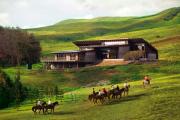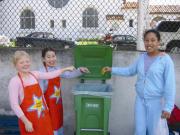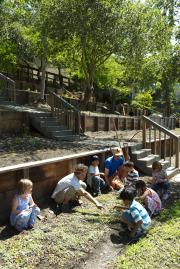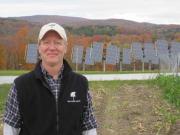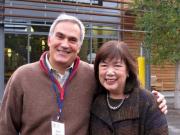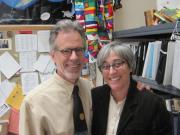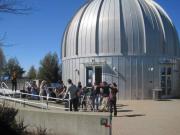The Green University Connection
This year while serving at a visiting scholar at Stanford and UC Berkeley I had an opportunity to study the important leadership role colleges and universities are playing in the environmental sustainability movement in education. Given its stature, size, and influence, the university community has provided a powerful example for change in the K-12 school community. The case studies of Stanford and Cal, followed by shorter reports on my visits to Mills College, Princeton and Yale, sketch the outlines of some of the best green practices in higher education.
1. Sustainable Stanford
During my year as a visiting scholar at Stanford, I had an opportunity to examine the university’s “Sustainable Stanford” initiative, one that orchestrates environmental efforts in research, teaching, facilities and operations.  Early on I met with School of Education Dean Deborah Stipek, who very generously sponsored my year’s work at my alma mater, and asked for guidance on how best to use the university’s resources in my search for best practices. Her advice was spot on: meet Professor Nicole Ardoin, get connected with the Woods Institute for the Environment, and learn about the Department of Sustainability initiatives.
Early on I met with School of Education Dean Deborah Stipek, who very generously sponsored my year’s work at my alma mater, and asked for guidance on how best to use the university’s resources in my search for best practices. Her advice was spot on: meet Professor Nicole Ardoin, get connected with the Woods Institute for the Environment, and learn about the Department of Sustainability initiatives.
Nicole Ardoin, Assistant Professor of Education and Center Fellow at the Woods Institute for the Environment, brings a unique perspective gained from her experience as an environmental educator and trained researcher to her inquiry into what motivates environmental behavior and how we can promote it. The daughter of two teachers, she was raised in communities around the world where they taught in international schools, and from a young age she developed a strong affinity with the outdoors.  After graduating from college she devoted herself to developing her career in non-formal, or informal environmental education, which takes place outside of traditional K-12 schools. She served in a variety of roles including an interpretative ranger at the Grand Canyon, a museum educator at Discovery Creek Children’s Museum in Washington DC, and an education specialist with World Wildlife Fund. Curious about what causes “pro-environmental behavior,” she pursued graduate study, receiving an M.S. in Environmental Resource Management from the University of Wisconsin and a M.Phil/Ph.D. in Social Ecology from the Yale School of Forestry and Environmental Studies.
After graduating from college she devoted herself to developing her career in non-formal, or informal environmental education, which takes place outside of traditional K-12 schools. She served in a variety of roles including an interpretative ranger at the Grand Canyon, a museum educator at Discovery Creek Children’s Museum in Washington DC, and an education specialist with World Wildlife Fund. Curious about what causes “pro-environmental behavior,” she pursued graduate study, receiving an M.S. in Environmental Resource Management from the University of Wisconsin and a M.Phil/Ph.D. in Social Ecology from the Yale School of Forestry and Environmental Studies.
Joining the Stanford faculty in 2008, she has brought an important dimension to the university’s overall sustainability initiative. In graduate school at Yale she teamed up with Professor Stephen Kellert to examine the impact of Sidwell Friends School’s new LEED platinum Middle School on the students and faculty. More recently, she has studied the relationship between a “sense of place, geographic scale, and environmental behavior.” She is especially interested in how education, communications, and social media can be used in non-formal settings to influence behavior; the results of her work promise to help the environmental movement sharpen its message in promoting a more sustainable world.
Recently I joined her seminar on the Theory and Practice of Environmental Education, a group of several dozen undergraduates and graduate students from a broad cross-section of fields, to talk about my own work studying the K-12 green schools movement. Speaking with two graduate students in environmental engineering gave me insight into the impressive way Stanford is engaging the best minds to join the environmental sustainability movement.  Sam Fox and Sara Barnowski share a great deal in common. Each grew up a small town (in Michigan and Connecticut respectively), graduated at the top of her public school class, and then received a degree from M.I.T. before coming to Stanford. Together they, and their fellow students in Nicole Ardoin’s seminar, represent the university’s strong effort to involve students in the Sustainable Stanford initiative and to prepare our young leaders for service.
Sam Fox and Sara Barnowski share a great deal in common. Each grew up a small town (in Michigan and Connecticut respectively), graduated at the top of her public school class, and then received a degree from M.I.T. before coming to Stanford. Together they, and their fellow students in Nicole Ardoin’s seminar, represent the university’s strong effort to involve students in the Sustainable Stanford initiative and to prepare our young leaders for service.
Through Nicole Ardoin I also discovered the Woods Institute for the Environment, founded a decade ago to harness “the expertise and imagination of leading academics and decision-makers to create practical solutions for people and the planet” in five core areas: Climate & Energy, Land Use & Conservation, Oceans & Estuaries, Freshwater, and Sustainable Built Environment. The institute provides funding for “environmental venture projects,” promotes strategic public-private collaborations, develops policy leaders, and offers educational fellowship programs.  On Earth Day I joined a stimulating forum, “Connecting the Dots: The Food, Energy, Water and Climate Nexus.” Leading off five hard-hitting presentations from Stanford faculty, Roz Naylor, director of the Program on Food Security and the Environment, argued we face enormous challenges: how to feed more people, especially the 1 billion hungry, and how to address equity issues in the developing world. As Professor David Lobell observed “food and climate are now tightly linked, in both directions,” and solutions to Naylor’s challenges will require increasingly sophisticated, quantified approaches to food production. Connecting the Dots provided a powerful example of Stanford’s commitment to finding solutions to our environmental challenges.
On Earth Day I joined a stimulating forum, “Connecting the Dots: The Food, Energy, Water and Climate Nexus.” Leading off five hard-hitting presentations from Stanford faculty, Roz Naylor, director of the Program on Food Security and the Environment, argued we face enormous challenges: how to feed more people, especially the 1 billion hungry, and how to address equity issues in the developing world. As Professor David Lobell observed “food and climate are now tightly linked, in both directions,” and solutions to Naylor’s challenges will require increasingly sophisticated, quantified approaches to food production. Connecting the Dots provided a powerful example of Stanford’s commitment to finding solutions to our environmental challenges.
When I met with Joe Stagner, Executive Director of the university’s Department of Sustainability and Energy Management (SEM), and his Associate Director Fahmida Ahmed, it quickly became apparent that Stanford is breaking new ground as it envisions a future where, in the words of President John Hennessey, sustainability will “become a core value in everything we do.” “As a community,” he notes, “we are committed to developing our core campus in a sustainable fashion that preserves what we cherish, that demonstrates leadership in the university’s commitment to be a good environmental steward and that safeguards the ability for future generations to thrive at Stanford.”
In the last half dozen years, Stanford has translated that vision into a mission that is bold and substantive, a “university-wide effort to reduce our environmental impact, preserve resources and show sustainability in action. We’re determined to lead in researching, teaching and practicing environmental sustainability.” The Sustainable Working Group, founded in 2006 by the President and Provost of the university, represents 25 different offices, departments and programs at the university, to steer various initiatives in sustainability.  To spearhead the design and implementation efforts, Stanford hired Joe Stagner from UC Davis, and he bought his training as a civil engineer, deep experience working on environmental issues from ground and waste water challenges to geothermal and solar renewable power, and a strong desire to promote action that is “real, verifiable and world class.” He soon recruited Fahmida Ahmed from UC Berkeley to galvanize the efforts and run the Office of Sustainability.
To spearhead the design and implementation efforts, Stanford hired Joe Stagner from UC Davis, and he bought his training as a civil engineer, deep experience working on environmental issues from ground and waste water challenges to geothermal and solar renewable power, and a strong desire to promote action that is “real, verifiable and world class.” He soon recruited Fahmida Ahmed from UC Berkeley to galvanize the efforts and run the Office of Sustainability.  As she observed, “we need to move beyond ‘random acts of greenness’ (RAGS) to a systemic approach on both planning and program front.” Together they lead a staff of over 100 people. With a total population of 30,000 students and employees, over 1000 buildings on 8000 acres, and 16 million square feet under management, Stanford is a small city with a large footprint, and for Stagner it is imperative to “reduce the resources we consume and leave less waste.”
As she observed, “we need to move beyond ‘random acts of greenness’ (RAGS) to a systemic approach on both planning and program front.” Together they lead a staff of over 100 people. With a total population of 30,000 students and employees, over 1000 buildings on 8000 acres, and 16 million square feet under management, Stanford is a small city with a large footprint, and for Stagner it is imperative to “reduce the resources we consume and leave less waste.”
After Stagner arrived in 2007, he designed Sustainability Working Teams focused on energy, green buildings, procurement, information technology, transportation, waster, water, as well as cross-functional teams that lead in the areas of communications, community relations, funding and evaluation. The working teams have a charter to develop long range sustainability plans and initiatives that are connected and facilitated by the Office of Sustainability in the center. As a manager, Stagner gave both direct responsibility and accountability to these groups.
The results of this systemic initiative and decade’s worth of sustainability best practices are impressive. With a goal to have new and remodeled buildings be at least 30% more efficient than energy code requirements, Stanford has since the early nineties saved over 240 million kilowatt hours of electricity and 72,000 metric tons of CO2.  The university diverts two-thirds of its waste from landfill, has achieved significant reductions in water use, decreased single-occupancy automobile trips to campus and increased shuttle bus rider ship by a third each, and expanded organic, locally grown produce to 40 percent. The Sustainable Stanford website contains many more examples of dramatic change.
The university diverts two-thirds of its waste from landfill, has achieved significant reductions in water use, decreased single-occupancy automobile trips to campus and increased shuttle bus rider ship by a third each, and expanded organic, locally grown produce to 40 percent. The Sustainable Stanford website contains many more examples of dramatic change.
Looking to the future, Stanford has embarked on an energy and climate initiative that promises to transform the school’s use of energy and serve as a model for other institutions to follow. With a verified, annual carbon footprint of approximately 180,000 metric tons, the university aims to achieve a 20% reduction in green house gas emissions from 1990 levels by 2020 and reduce its domestic water use by 18%. This will be accomplished through energy efficiency in new buildings, energy conservation in existing buildings, and an innovative new energy supply process called heat recovery.  This process will retrofit a central, natural gas burning energy facility with a plant that uses a sophisticated process of heat recovery and cooling that is powered from the electric grid. According to the Sustainable Stanford website, the university estimates that it will save over $635 million in the next 40 year when it is approved by the Board of Trustees.
This process will retrofit a central, natural gas burning energy facility with a plant that uses a sophisticated process of heat recovery and cooling that is powered from the electric grid. According to the Sustainable Stanford website, the university estimates that it will save over $635 million in the next 40 year when it is approved by the Board of Trustees.
Clearly, Stanford is leading the way in developing world-class environmental programs and is a university that is serious about sustainability.
2. University of California, Berkeley: World Class Sustainability
Halfway through my year as a visiting scholar at UC Berkeley, I made a remarkable discovery: Cal was named the “world’s greenest university” by the International Business Times. While it may be a challenge to rank green universities with precision, the article brought well-deserved attention to Berkeley’s significant efforts to be a leader in environmental sustainability.  My conversations throughout the year with those engaged in the effort, beginning with Dean of the Graduate School of Education Judith Warren Little who generously sponsored my work as a visiting scholar, helped me understand the vital role UC Berkeley is playing in the national sustainability effort.
My conversations throughout the year with those engaged in the effort, beginning with Dean of the Graduate School of Education Judith Warren Little who generously sponsored my work as a visiting scholar, helped me understand the vital role UC Berkeley is playing in the national sustainability effort.
Nearly a decade ago the President and the Board of Regents of the University of California, at the urging of concerned and engaged students, established the first system-wide Policy on Sustainable Practices, which declares that “resource sustainability is critically important to the University of California, the State of California, and the nation.” The UC Berkeley success itself stems in part from the continued leadership of Chancellor Robert Birgeneau and his 2007 pledge, the “Campus Commitment to the Environment,” that the university would reduce its Greenhouse Gas Emissions to 1990 levels by 2014. A physicist by training, he led Cal to establish clear, measurable goals with annual reports on progress. As he noted in the 2009 Campus Sustainability Plan, “By compiling our sustainability goals and strategies and addressing a broad range of environmental aspects, UC Berkeley is planning for the future and setting the bar high.”
In December 2010 the University of Indonesia released the results of its Green Metric Ranking, a study of several thousand universities around the world and named UC Berkeley number one. According to the International Business Times, the analysis took in to account “location, amount of green space, electrical consumption, waste management, as well as policies, actions, and communication related to sustainability.” Cal’s 2010 Campus Sustainability annual report identifies some of the university’s green achievements.  The university is making significant progress in reducing greenhouse gas emissions; since 2006, as a result of multiple energy-reduction projects in new and existing campus buildings electricity usage has declined by 11.5 million kWh and emissions by about 5,000 tons, with a total cost savings of almost $1.4 million. The number of green campus vehicles has tripled since 2006 and fuel use has declined 28% since 1990. Campus water usage has dropped by more than 10% since 1990. Solid waste diversion is now 57%, including the many construction projects underway. And Cal Dining estimates 27% of its purchases are from sustainable providers.
The university is making significant progress in reducing greenhouse gas emissions; since 2006, as a result of multiple energy-reduction projects in new and existing campus buildings electricity usage has declined by 11.5 million kWh and emissions by about 5,000 tons, with a total cost savings of almost $1.4 million. The number of green campus vehicles has tripled since 2006 and fuel use has declined 28% since 1990. Campus water usage has dropped by more than 10% since 1990. Solid waste diversion is now 57%, including the many construction projects underway. And Cal Dining estimates 27% of its purchases are from sustainable providers.
The university’s sustainability commitment is notable in the many campus construction projects currently underway. According to Judy Chess, Assistant Director of the UC Green Building Programs, in 2008 it became an “expectation” that construction and renovation projects would be LEED certified as the university wanted assurance that the highest standards would be met. Even in challenging economic times, the campus policy on Green Building Design has continued to set a high bar.  Since 2008 the campus has completed five projects--three new buildings and two renovations, including student housing, offices, a research center, and a lab--and all were LEED certified, two silver and two gold; there are another 11 projects either under construction or contemplated and LEED certifications are all expected within half a year of completion of the building project. One of the most remarkable is the new Helios Energy Research Facility--the project of former Lawrence Berkeley Laboratory Director Steven Chu who is now U.S. Secretary of Energy--a center focused on the development of renewable, carbon-neutral fuels.
Since 2008 the campus has completed five projects--three new buildings and two renovations, including student housing, offices, a research center, and a lab--and all were LEED certified, two silver and two gold; there are another 11 projects either under construction or contemplated and LEED certifications are all expected within half a year of completion of the building project. One of the most remarkable is the new Helios Energy Research Facility--the project of former Lawrence Berkeley Laboratory Director Steven Chu who is now U.S. Secretary of Energy--a center focused on the development of renewable, carbon-neutral fuels.
As a member of the UC Library Advisory Board, I have been excited to be part of the effort that will renovate the Moffitt Undergraduate Library to become more sustainable.  Built in the 1970s and located in the heart of the campus near Strawberry Creek and a glade of redwood trees, Moffitt promises to be a model of sustainability and likely will be certified at a LEED gold level. As University Librarian Tom Leonard says, the building will feature the best practices in green architecture: “building technology, low-energy design, and occupant comfort and safety are three main areas of focus.
Built in the 1970s and located in the heart of the campus near Strawberry Creek and a glade of redwood trees, Moffitt promises to be a model of sustainability and likely will be certified at a LEED gold level. As University Librarian Tom Leonard says, the building will feature the best practices in green architecture: “building technology, low-energy design, and occupant comfort and safety are three main areas of focus.  Plans currently include improving the building envelope (windows, wall and roof insulation), incorporating sun shading, creating day-lit interiors, using low-energy and high-efficiency light sources, meeting Energy Star plug loads, using compressor-free cooling, separating ventilation system from thermal comfort, using high-efficiency air filtration, allowing outside air ventilation, installing low-water use fixtures, and monitoring energy use to make needed adjustments.” As associate University Librarian and Moffitt project director Beth Dupuis observes, “The renewed library will embrace an exciting range of learning environments that are essential to our current students and can be adapted to meet future needs.”
Plans currently include improving the building envelope (windows, wall and roof insulation), incorporating sun shading, creating day-lit interiors, using low-energy and high-efficiency light sources, meeting Energy Star plug loads, using compressor-free cooling, separating ventilation system from thermal comfort, using high-efficiency air filtration, allowing outside air ventilation, installing low-water use fixtures, and monitoring energy use to make needed adjustments.” As associate University Librarian and Moffitt project director Beth Dupuis observes, “The renewed library will embrace an exciting range of learning environments that are essential to our current students and can be adapted to meet future needs.”
Through the student representative to the Library Advisory Board, senior Claire Evans, I learned about the significant impact undergraduate and graduate students are making through the program called Building Sustainablity at Cal.  Raised in nearby Piedmont, Claire herself developed a passion for environmental justice, through time spent in the High Sierra with her family and in her AP Environmental Science class in high school. As a freshman she joined BS@C, whose mission is to reduce the university’s environmental impact by creating a sustainability culture. As a junior double major in Society & Environment and Urban Studies, she served as co-chair of the program that trains students to work with university personnel on actual building energy audits and to design projects to change behavior. In May I attended the group’s annual presentation to the Vice Chancellor organized by her successor as program chair Sruti Bharat, a third year major in Industrial Engineering and Operations Research.
Raised in nearby Piedmont, Claire herself developed a passion for environmental justice, through time spent in the High Sierra with her family and in her AP Environmental Science class in high school. As a freshman she joined BS@C, whose mission is to reduce the university’s environmental impact by creating a sustainability culture. As a junior double major in Society & Environment and Urban Studies, she served as co-chair of the program that trains students to work with university personnel on actual building energy audits and to design projects to change behavior. In May I attended the group’s annual presentation to the Vice Chancellor organized by her successor as program chair Sruti Bharat, a third year major in Industrial Engineering and Operations Research.  The student reports described impressive, real-world problem solving projects that ranged from innovative recycling signage in campus buildings to teaching sustainability in the Berkeley public schools. Cal’s long history of training citizen leaders is clearly alive and well!
The student reports described impressive, real-world problem solving projects that ranged from innovative recycling signage in campus buildings to teaching sustainability in the Berkeley public schools. Cal’s long history of training citizen leaders is clearly alive and well!
As one of the world’s top research universities, Cal aims to be a global leader in addressing the challenges of climate change, through the Lawrence Berkeley Laboratory and its new Energy Bioscience Institute that will be located in the new Helios facility. Over three hundred researchers are trying to find alternatives to our dependence on fossil fuel and ways to mitigate our growing demand for energy. Consider a sampling of the extraordinary projects currently underway: a project to mimic photosynthesis with artificial materials, engineering microbes to produce fuel directly from plants, a method to automatically reuse grey in the home and in commercial buildings, an urban design called an “eco-block” that produces its own energy, is off the grid, and processes the waste and water it generates. In a project that has generated great interest, physics professor Dan Kammen, who is also a parent and member of the Board of Trustees at Head-Royce School, worked with graduate students in his energy lab to invent a plan to market solar energy. With the City of Berkeley, Kammen came up with a financing method that enables the city to advance the upfront costs of solar panels, the cost of which is then amortized as a special property tax over a period of years. The plan has now been embraced by nearly half the states in the country.
The commitment of the University of California to a more environmental sustainable future is remarkable. As a visiting scholar, I have been privileged to learn about some of the many ways Cal is making a difference.
3. Mills College: Women Leading Sustainably
During her twenty-three year tenure as president of Mills College, Jan Holmgren has done a remarkable job to secure the future of this historic women’s college. When she arrived at the college in 1988, and her daughter enrolled at Head-Royce School, we discovered that we had been high school classmates in Hinsdale, Illinois. While we were both good students, there was a difference between us: Jan graduated in just three years, and was the valedictorian of the class ahead of us!
While at Mills, Jan Holmgren has been recognized for her national leadership in environmental sustainability, which included her pledge to participate in the American and University College Presidents Climate Commitment, which declared that global warming is “the defining challenge of the 21st century...a crisis that threatens society’s very viability,” one in which higher education has a “moral and social responsibility to rise to this challenge.” As she said recently, “Global warming is happening so fast, we have to address this challenge.”  As a result of her initiatives, the college’s sustainability record is strong. Mills has established that all construction would be at the LEED silver level or above, participated in RecycleMania, encouraged the use of public and shared transportation, and became a member of the Association for the Advancement of Sustainability in Higher Education (AASHE).
As a result of her initiatives, the college’s sustainability record is strong. Mills has established that all construction would be at the LEED silver level or above, participated in RecycleMania, encouraged the use of public and shared transportation, and became a member of the Association for the Advancement of Sustainability in Higher Education (AASHE).
After moving to California, Holmgren saw opportunity to ensure that the college’s facilities model sustainable best practices. First in the new School of Education complex, and then in new science and business school buildings, Mills learned how to build green. Impressed by the “economic facts” about green buildings and favorable returns on investments, and with a belief that a “green, cutting edge campus could be more attractive to students,” she set in motion a new approach to the built environment at the college.  The Moore Natural Sciences Building was certified LEED platinum in 2007 and features solar panels on the roof, a rainwater collection system, efficient mechanical systems, drought tolerant plantings, and recycled materials.
The Moore Natural Sciences Building was certified LEED platinum in 2007 and features solar panels on the roof, a rainwater collection system, efficient mechanical systems, drought tolerant plantings, and recycled materials.  The new Lokey Graduate School of Business received LEED gold certification in 2010 and takes advantage of a lovely site, natural light and ventilation.
The new Lokey Graduate School of Business received LEED gold certification in 2010 and takes advantage of a lovely site, natural light and ventilation.
These changes resulted from the college’s vision of sustainability for its 135-acre, 150 year old campus in Oakland that is dedicated to the “preservation of the natural environment with a strong focus on the future.” Mills seeks to create a “sustainable future where we maintain and improve the campus ecosystem, build sustainability into the curriculum, encourage inquiry and environmental justice.” The college has developed initiatives to preserve the campus environment, with a Landscape Heritage Plan, sustainable vegetation management, creek and lake restoration. With strong engagement from the student body, the college won first place for composting in the RecycleMania 2008 competition. And in 2010 the Princeton Review cited Mills among the nation’s greenest colleges.
In another personal connection, I recently met the new Dean of the School of Education, Kathy Schultz, the younger sister of a college classmate. Strolling the beautiful grounds of her new school, she revealed that over the course of her career she herself has been a committed environmentalist.  Raised in Virginia, she had a chance to attend a summer camp sponsored by the Burgundy Day School in Alexandria called the Burgundy Center for Wildlife Studies in West Virginia, where she later taught botany and banded birds. The love of nature led her eventually to earn a B.S. from Yale with a major she designed in environmental education, “before it was fashionable.” She spent a decade teaching grades 1, 4 and 5 in elementary school and serving as a science specialist in Philadelphia and was the director of the Farm and Wilderness Campus in Plymouth, Vermont over several summers. With an M.Ed. from Lesley College and a Ph.D. from the University of Pennsylvania, where she taught for over a decade, she is an expert on teacher education and literacy. She hopes to bring her love of the environment to bear on her new work in California.
Raised in Virginia, she had a chance to attend a summer camp sponsored by the Burgundy Day School in Alexandria called the Burgundy Center for Wildlife Studies in West Virginia, where she later taught botany and banded birds. The love of nature led her eventually to earn a B.S. from Yale with a major she designed in environmental education, “before it was fashionable.” She spent a decade teaching grades 1, 4 and 5 in elementary school and serving as a science specialist in Philadelphia and was the director of the Farm and Wilderness Campus in Plymouth, Vermont over several summers. With an M.Ed. from Lesley College and a Ph.D. from the University of Pennsylvania, where she taught for over a decade, she is an expert on teacher education and literacy. She hopes to bring her love of the environment to bear on her new work in California.
With Jan Holmgren’s retirement in July, Mills College has appointed a new president, Alecia A. DeCoudreaux. Holmgren believes the college is poised for continued leadership in environmental sustainability. “We have a strong team in place, have made significant investments, and have a strategic plan for change.” With its commitment to educating women leaders, Mills appears ready to fulfill that pledge.
